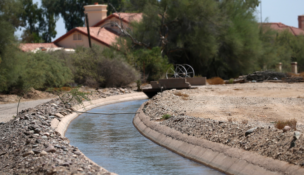O’Halleran wants to change water-conservation law
Arizona Capitol Reports Staff//January 3, 2008//[read_meter]
O’Halleran wants to change water-conservation law
Arizona Capitol Reports Staff//January 3, 2008//[read_meter]
A state senator is preparing to modify a key provision of a law passed last year that more strictly tied approval of new development to proof that it will have an adequate long-term water supply.
The new law allows rural local governments to hinge their approval of new subdivisions on whether there will be enough water to support them for 100 years.
But a county’s board of supervisors has to adopt the change unanimously.
Sen. Tom O’Halleran, R-1, wants to make it a majority, rather than a unanimous consent.
The move would likely set up O’Halleran for another round of fierce debate over how best to manage the state’s most precious resource — water. The issue likely will be contentious because the modification would have a direct impact on growth and development in rural areas.
“To give one person sole veto power over water management in an area just doesn’t make any sense,” O’Halleran told the Arizona Capitol Times .
That was the crux of his argument last session, along with his view that water management in rural areas is currently negligible and that growth should not come at the expense of future generations’ access to affordable water.
But supporters of the provision countered that the change sought by the water-adequacy bill last year could have lasting impacts, and that the entire board should give approval before it was adopted.
In fact, the passage of last session’s law was a landmark decision, one of the biggest since Arizona imposed water restrictions in fast-expanding urban territories, now known as active management areas or AMAs.
By passing S1575, the state moved toward a path already taken within AMAs, which were created in the 1980s to deal with severe water problems.
The State Water Advisory Group (SWAG) has recommended expanding the requirement to areas outside AMAs. The group began meeting in 2006 to discuss how Arizona can best prepare for future water shortages. The group was made up of about 50 members, including county supervisors, city and state lawmakers, business officials and water providers.
The bill signed last year was the product of negotiation among stakeholders. The law’s author, Senate Minority Leader Marsha Arzberger, said she would not make any changes to it unless stakeholders agreed to the change.
Arzberger has indicated she is willing to re-examine this provision. But her support for any change hinges on what stakeholders have to say, and on maintaining that consensus reached when they passed the water adequacy bill, she said.
“If the issue is reexamined and the consensus is that a majority is better, then let’s go with the majority,” she said. “So, it depends on a re-discussion.”
In fact, Arzberger said she initially supported the majority-vote concept, but went with the unanimous vote provision because that was the consensus. Any water policy is tough to pass, she said. In this case, they had started out with SWAG and later asked for input from industries and other groups.
“To bring all those people together is difficult negotiation,” she said. “Now as sponsor, I would not go back and change it unless all of those people who agreed to it before are still in agreement, because I hold to my word.”
If it were just one county supervisor taking a stance that is different from the rest, then there are other ways to compel that county’s board of supervisors to adopt the change, according to the minority leader. She cited the experience of Cochise County, where voters rejected a proposition and thereby overturned a decision by the Board of Supervisors’ to rezone certain land to allow development. Cochise residents felt the move would adversely impact water resources and the county’s rural lifestyle.
The real estate industry had closely tracked the progress of S1575, because it would have a major impact on housing, a main engine of economic growth in Arizona.
Tom Farley, real estate industry lobbyist has said any legislation “needs to be balanced with a carrot-and-stick approach.” Previous efforts to bring water regulation to rural Arizona have only been approached from the punishment point of view, he said.
“In order to help rural Arizona to effectively manage the water supply, they’re going to need help with building infrastructure just like the five AMAs receive,” he had said. In short, a stricter regulation should come along with funds earmarked for water infrastructure, said Farley, who represents the Arizona Association of Realtors and the Northern AZ Builders Association.
While neutral on S1575, Farley said he supports its unanimous-vote provision. “I think what it does is that it actually puts the power equally in everybody’s hands who were elected,” he said.
O’Halleran said he hopes colleagues will be closely listening as he pushes for the majority vote this session.
“I think there is a critical need for legislators to understand the hard issue here — that water management in rural Arizona is negligible right now,” he said. Nobody is saying you can’t have development, he said.
“But we need to develop in a way that is not going to be hurtful of our natural resources and our citizens’ ability to have water at a reasonable cost,” he said.
Both O’Halleran and Arzberger agree that the work is far from over and that the discussions on water management should continue.
Arzberger said a dedicated fund has to be secured to provide for water-development grants at the local level. O’Halleran said he is also preparing legislation that would require counties, cities and towns within a groundwater basin to meet every few years and discuss water-management issues on a more regional basis.
















